Main menu:

You find more northern birds in these parts:
Migrating birds, Taigaforest birds and Birds of Lapland fjelds (=mountains) !
The most abundant nesting birds in Finland are: willow warbler (about 10 million couples), chaffinch, tree pipit, redwing, bramling, spotted flycatcher, siskin, fieldfare, yellowhammer, robin.
The emphasis of mire (= peatland) and fell birds is in the north. Common mire birds there are for example meadow pipit, yellow wagtail, wood sandpiper, willow grouse and curlew. In the fells there are nesting about 20 species, like snow bunting, ptarmigan, golden plover, dotterel, lapland bunting and bluethroat. See the sections "Birds of fjelds" and "Migration of birds"!
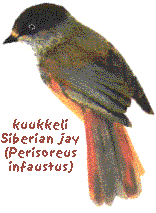 is definitely familiar if you have for example been trekking in Lapland. It’s very curious to know what you are ‘having for lunch’ in a break. This brown-red-greyish bird is also called the northern Finland’s jay. Siberian jay is our smallest crow bird, during nesting time it is hiding but in the summer it is very curious and almost half tame, the lucky bird of the Sami people.
is definitely familiar if you have for example been trekking in Lapland. It’s very curious to know what you are ‘having for lunch’ in a break. This brown-red-greyish bird is also called the northern Finland’s jay. Siberian jay is our smallest crow bird, during nesting time it is hiding but in the summer it is very curious and almost half tame, the lucky bird of the Sami people.
As a omnivorous bird it will certainly check all break places after hiker in order to find crumbs. It is a resident bird so it won’t migrate away for winter.
The distribution of siberian jay is limited to Northern Finland. It’s also the province bird of the Kainuu province and it lives in the old spruce forests. Siberian jay hides its nest in a tall spruce and starts nesting already in March. The dam broods its eggs despite of the possible snowstorms and lively fledglings can be seen already in May - June.
Siberian jay has many names given by folks and it’s also a bird of many beliefs. It’s quite poor singer, it meows, screeches and squeaks so it’s the troll of the forest. Germans have called it the bad luck jay, so in the north it brings luck and the opposite in the south.
Willow grouse is mainly northern bird but lives also in the southern parts of the Central Finland. It has been very important for Lapps as food and as a source of income, and still is. It used to be ‘the fourth money’ in Lapland. The fluctuation of grouse population is common. In year 2009 discussed in Finland about the restriction of hunting time of grouse, like in Norway.
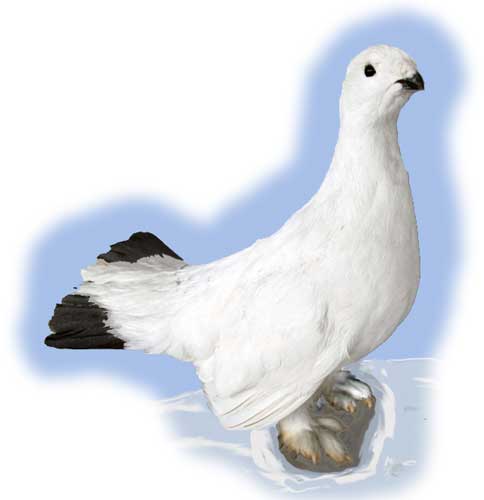
The yipping laughter of willow grouse can startle when you hear it for the first time, but more experienced hiker is anxious to hear it. In the courtship the male willow grouse grunts peacefully and the female meows back.
During the wintertime willow grouse has a white ‘snow outfit’ despite the black edg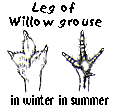 e feathers of the tail, so it’s very difficult to see in the snow. The feather layer in the winter is very effective against the cold, a real fur. Even legs are covered with feathers. In the summer willow grouse is mostly red-brownish only wings and stomach are white. Its track in the snow is very good distinctive mark. In the winter it sleeps under the snow cover, there can be tens of them in the same place. In April couples find their own territories. Willow grouse is monogamous.
e feathers of the tail, so it’s very difficult to see in the snow. The feather layer in the winter is very effective against the cold, a real fur. Even legs are covered with feathers. In the summer willow grouse is mostly red-brownish only wings and stomach are white. Its track in the snow is very good distinctive mark. In the winter it sleeps under the snow cover, there can be tens of them in the same place. In April couples find their own territories. Willow grouse is monogamous.
See: population fluctuation of willow grouse!
.Willow grouse - like Ptarmigan - is well adapted to norhern conditions.
Ptarmigan reminds a lot of willow grouse. It lives in the uppermost parts of fells, mainly in rocky places.
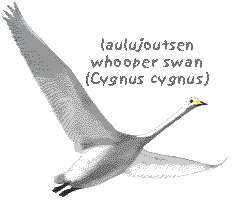 The national bird of Finland, whooper swan is a bird of myths and symbols. After last wars it almost disappeared but the book trilogy by Yrjö Kokko made Finns to think and the persecution was over. After that it became tame and distributed almost all over our country. There are about 4000 nesting couples in Finland at present.
The national bird of Finland, whooper swan is a bird of myths and symbols. After last wars it almost disappeared but the book trilogy by Yrjö Kokko made Finns to think and the persecution was over. After that it became tame and distributed almost all over our country. There are about 4000 nesting couples in Finland at present.
Because of the white outfit the whooper swan is the symbol of purity and its lifetime fidelity to its partner is noticed in the sayings of folks. They find their partners in the second year and choose the nesting place and they live there together without nesting, which starts on the third or fourth year.
They eat submerged water plants and shore vegetation and also small fauna. It doesn’t dive completely under the water when it’s seeking food.
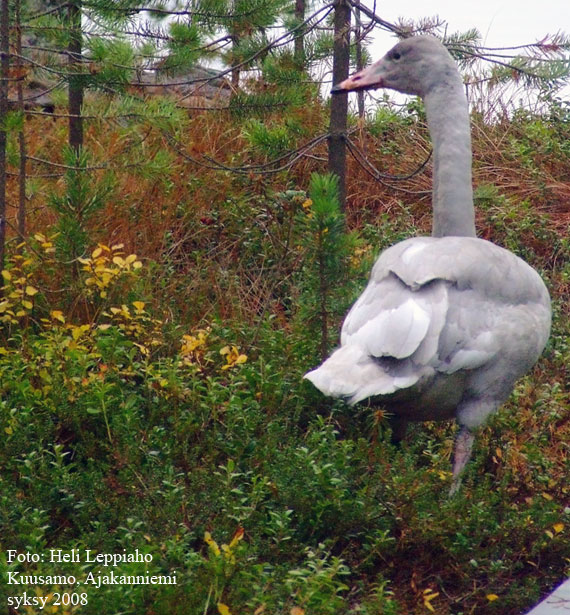
Young bird (born in summer 2007) had in the same autumn an excursion to the strandforest.
After observations this swan catched some berries of blueberry (Vaccinium myrtillus).
Whooper swan arrives very early, when there is still the snow cover. It’s very resistant to cold as long as there are ice-free places to find food. It has to come very early and start to nest quickly because it takes at least four months in the open water until the fledglings are able to fly.
Our other swan, mute swan is even more demanding, it takes four months before it’s fledglings are old enough to fly and that’s why it can only live in Southern Finland.
Here you can see more pictures and the timetable of migration of northern birds:
If you like some other birds, click here!
If you like some other animals, click here!